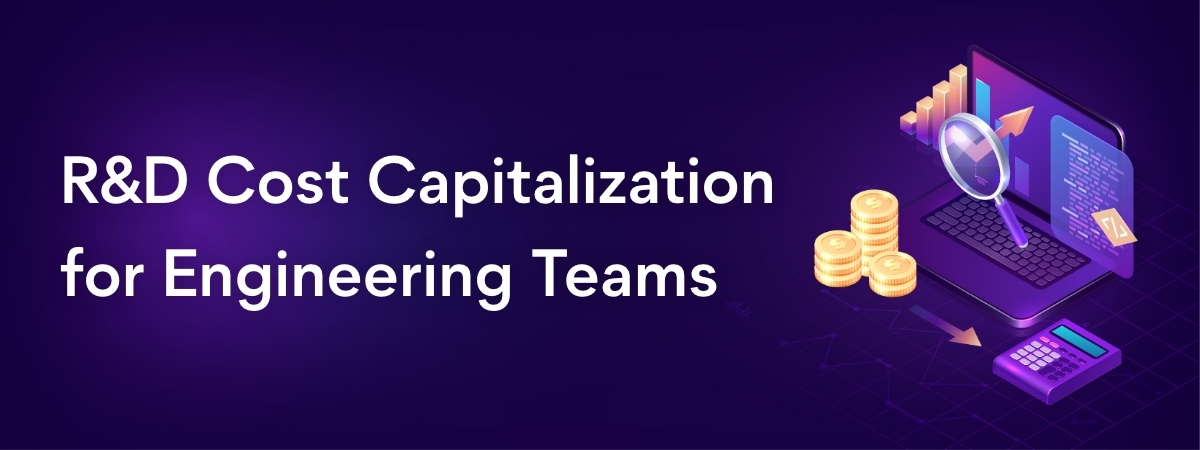Research and Development (R&D) has become the hub of innovation and competitiveness in the dynamic world of modern business. A deliberate and perceptive strategy is required to successfully navigate the financial complexities of R&D expenses.
When done carefully, the process of capitalizing R&D expenses has the potential to produce significant benefits. In this blog, we dive into the cutting-edge R&D cost capitalization techniques that go beyond the obvious, offering practical advice to improve your financial management skills.
What is R&D cost capitalization?
Capitalizing R&D costs is a legitimate accounting method that involves categorizing software R&D expenses, such as FTE wages and software licenses, as investments rather than immediate expenditures. Put more straightforwardly, it means you’re not merely spending money; instead, you’re making an investment in the future of your company.
Capitalizing on R&D costs entails a smart transformation of expenditures into strategic assets supporting a company’s financial structure beyond a simple transaction. While traditional methods follow Generally Accepted Accounting Principles (GAAP), it is wise to investigate advanced strategies.
One such strategy is activity-based costing, which establishes a clear connection between costs and particular R&D stages. This fine-grained understanding of cost allocation improves capitalization accuracy while maximizing resource allocation wisdom. Additionally, more accurate appraisals of R&D investments can be produced using contemporary valuation techniques suited to your sector’s dynamics.
Software costs that qualify for capitalization
This is to be noted that only some expenditures can be converted into assets. GAAP guidelines are explicit about what qualifies for cost capitalization in software development. R&D must adhere to specific conditions to be recognized as an asset on the balance sheet. These include:
Technology should be feasible
The capitalizable cost should be contributing to a tangible product or process.
Commitment to finish
The firm’s commitment should evolve into a well-defined plan. The half-hearted endeavors should be eliminated.
Economic possibilities
Projections for market entry and the product must yield financial returns in the future.
In software development costs, GAAP’s FASB Account Standard Codification ASC Topic 350 – Intangibles focuses on internal use only software eligible for capitalization:
- Software developed for internal use only. If the company plans to sell the prototype, it becomes an expense.
- Activities that are undertaken during the development stage – Testing, coding, and installation.
- FTE compensation for engineers involved in the development during the specified period.
That being said, FASB Accounting Standards Codification (ASC) Topic 985 – Software addresses sellable software for external use. It covers:
- Costs that are incurred in the technology feasibility stage.
- Activities during the development stage, such as testing, coding, installation, independent consultations, product development, and FTE compensation.
Note that, costs related to initial planning and prototyping cannot be capitalized. Therefore, they are not exempted from tax calculations.
In R&D capitalization, tech companies typically capitalize on engineering compensation, product owners, third-party platforms, algorithms, cloud services, and development tools.
Although, In some cases, an organization’s acquisition targets may also be capitalized and amortized.
Making decisions based on insights using investment balance tools
Enhancing your understanding of R&D cost capitalization necessitates adopting techniques beyond quantitative data to offer a comprehensive view of your investments. These tools transform numerical data into tactical choices, emphasizing the critical importance of data-driven insights.
Adopt tools that are strengthened by advanced analytics and supported by artificial intelligence (AI) prowess to assess the prospects of each R&D project carefully. This thorough review enables the selection of initiatives with greater capitalization potential, ultimately optimizing the investment portfolio. Additionally, these technologies act as catalysts for resource allocation consistent with overarching strategic goals.
In Typo, you can use “Investment distribution” to allocate time, money, and effort across different work categories or projects for a given period of time. Investment distribution helps you optimize your resource allocation and drive your dev efforts towards areas of maximum business impact.
These insights can be used to evaluate project feasibility, resource requirements, and potential risks. You can allocate your engineering team better to drive maximum deliveries.

Amortization techniques for comprehensive financial management
Effective amortization is the trajectory, while capitalization serves as the launchpad, defining intelligent financial management. For amortization goals, distinguishing between the various R&D components necessitates nothing less than painstaking thought.
Advanced techniques emphasize personalization by calibrating amortization periods to correspond to the lifespan of specific R&D assets. Shorter amortization periods are beckoned by ventures with higher risk profiles, reflecting the uncertainty they carry. Contrarily, endeavors that have predictable results last for a longer time. This customized method aligns costs with the measurable gains realized from each R&D project, improving the effectiveness of financial management.
Tailoring R&D capitalization to industry dynamics
R&D cost capitalization should be tailored to the specific dynamics of each industry, taking into account the specifics of each sector. Combining agile approaches with capitalization strategies yields impressive returns in industries like technology, known for their creativity and flexibility.
Capitalization strategies dynamically alter when real-time R&D progress is tracked using agile frameworks like Scrum or Kanban. This realignment makes sure that the moving projects are depicted financially accurately. Your strategy adapts to the contextual limits of the business by using industry-specific performance measures, highlighting returns within those parameters.
A comprehensive plan for effective financial governance
Controlling the complexities of R&D financial management necessitates an ongoing voyage marked by the fusion of approaches, tools, and insights specific to the sector. Combining the methods presented here results in a solid framework that fosters creativity while maximizing financial success.
It is crucial to understand that the adaptability of advanced R&D cost capitalization defines it. Your journey is shaped by adapting techniques, being open to new ideas, and being skilled at navigating industry vagaries. This path promotes innovation and prosperity in the fiercely competitive world of contemporary business and grants mastery over R&D financials.
Related posts:
 6 effective Ways to reduce technical debt
6 effective Ways to reduce technical debt
 The Ultimate DORA DevOps Guide: Boost Your Dev Efficiency with DORA Metrics
The Ultimate DORA DevOps Guide: Boost Your Dev Efficiency with DORA Metrics
 ‘How to lead engineering teams efficiently?’ with Francisco Trindade, Director of Engineering, Braze
‘How to lead engineering teams efficiently?’ with Francisco Trindade, Director of Engineering, Braze
 ‘How to set the right foundation for engineering teams?’ with Gregor Ojstersek, CTO at Zorion
‘How to set the right foundation for engineering teams?’ with Gregor Ojstersek, CTO at Zorion

